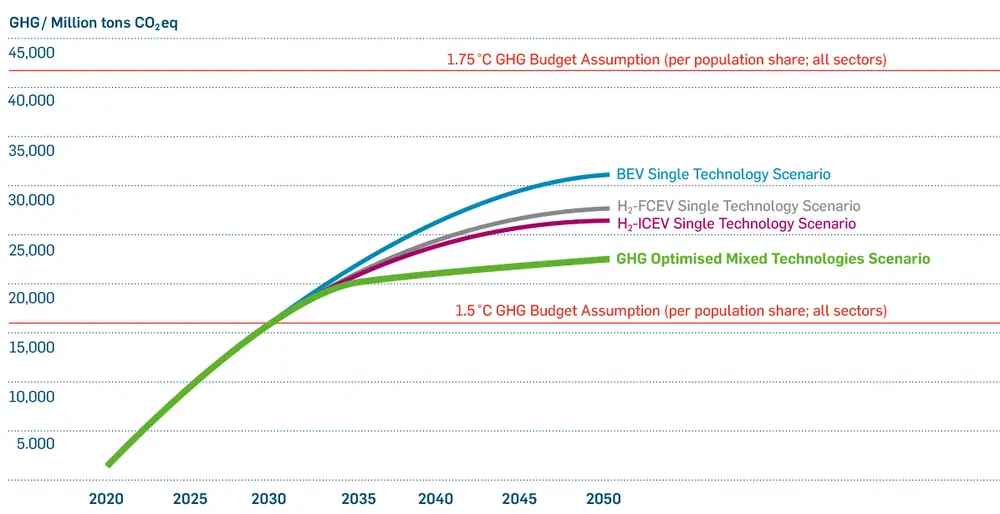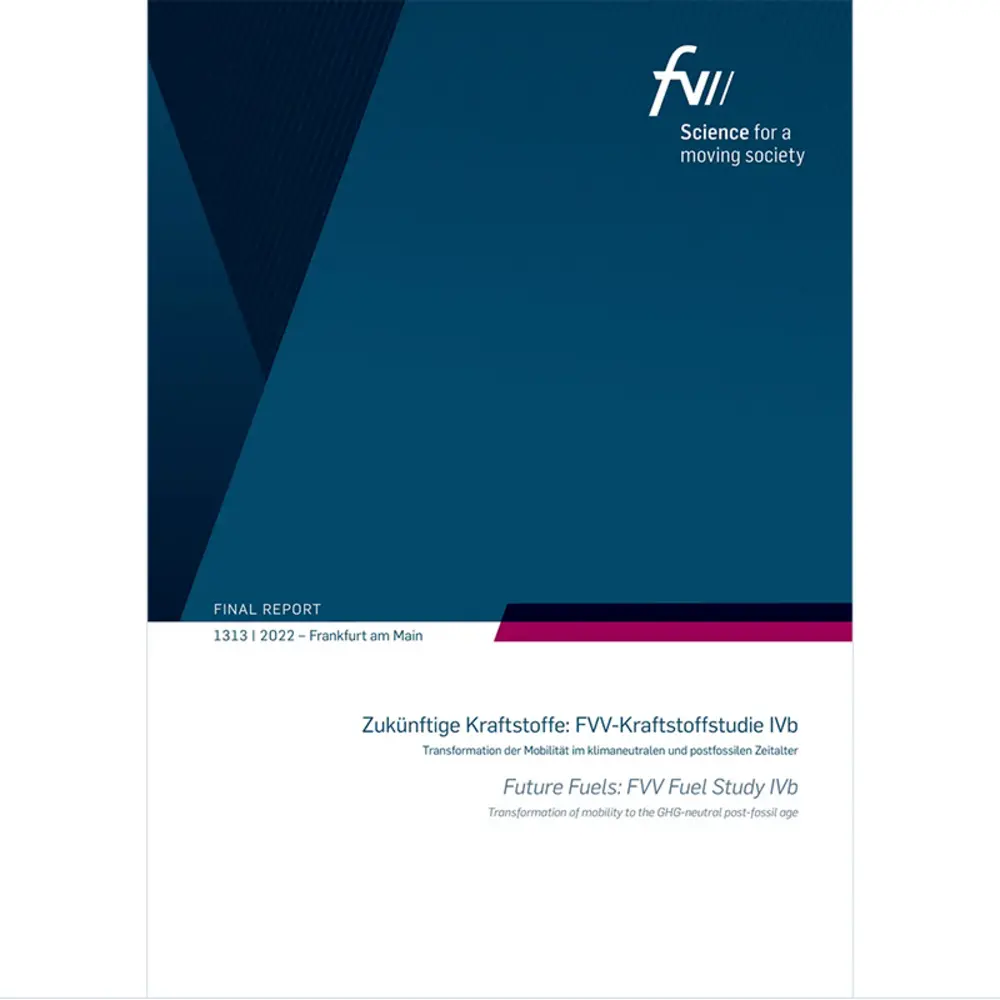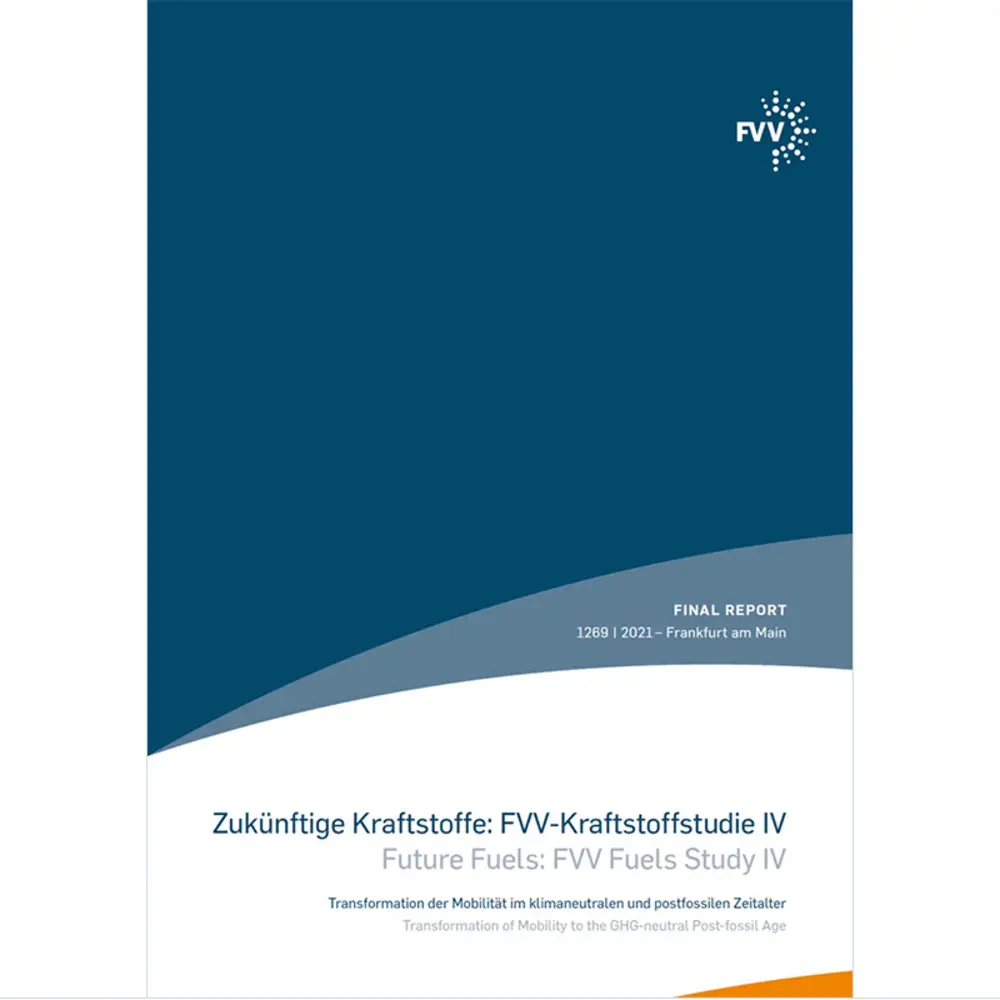How we are speeding up the green transformation
Thanks to the Green Deal, Europe is to become the first climate-neutral continent that eliminates as many CO2 emissions as it produces by 2050. To allow the green transformation to pick up momentum, the principle of achieving carbon neutrality as quickly as possible must be the basis for political decisions.
Contents
Diversification is our firmest route to decarbonising mobility in Europe
Based on the findings of the studies on the life-cycle assessment of climate-neutral and resource-friendly powertrain systems, FVV has drawn up a research roadmap of activities (MAKE IT NEW) centring around the potential of all energy converters and carriers that are based on renewable resources.
This diversification gives politicians, scientists, society and industry the tools they need to evaluate new developments for dispensing with fossil fuels as quickly as possible and adopting carbon-neutral technologies for the various sectors, and to launch them on the market.
Diversification also creates redundancies among the energy carriers and converters, which has the effect of safeguarding the goal of climate neutrality by 2050 against factors that are difficult or impossible to estimate or assess. If, for example, a geopolitical problem or an issue with the supply of raw materials delays the ramp-up of one technology, this can be largely compensated by using a different technology.
A strategy of diversifying energy carriers and converters...
- accelerates the ramp-up of carbon-neutral technologies
- will make the transport sector climate-neutral sooner
- safeguards the climate goals against impenetrable factors
- is the only way to achieve the climate goals set by the EU and Germany in the transport sector.
Politicians and society must act fast
FVV therefore calls for society and the political arena:
- to actively promote the diversification of energy carriers and converters in the European transport sector. If additional renewable energy carriers are not considered, we are in danger of leaving potential for reducing CO2 emissions unused, failing to defossilise energy carriers as quickly as possible and therefore unnecessarily increasing cumulative CO2 emissions.
- to base political decisions and specifications on a comprehensive LCA, while existing laws and guidelines must be examined on the basis of this and amended where needed.
In view of the incalculable challenges we are facing today (energy costs, raw material bottlenecks, supply chains and the geopolitical situation), FVV recommends that:
- in addition to the electrification of transport and the infrastructure associated with this, politicians and society should provide broad access to alternative energy carriers such as renewable hydrogen and liquid e-fuels. This is all the more important when one considers that the studies illustrate the outstanding leverage of these technologies for reducing CO2 emissions, as well as the still large percentage of overall CO2 emissions that will be generated by the existing vehicle fleet in the future.
- regulators should define intermediate steps on the road to carbon neutrality in the EU by 2050 and establish suitable mechanisms to assess their achievement.
FVV studies at a glance
Frequently asked questions
The primary energy demand in Germany lies currently in the region of 3,600 TWh per year (EU: approx. 19,000 TWh per year). The final energy demand is approx. 2,600 TWh per year. The difference results from unavoidable energy losses that occur during transport and especially during conversion from one form of energy to another. A robust design of a future energy system must not be based on minimum estimates of future energy demand, as this would endanger energy security. According to FVV estimates, Germany's future minimum final energy demand is likely to be a magnitude of at least 2,300 TWh per year. In terms of unavoidable conversion losses, a figure of at least 400 TWh per year should be assumed. These figures result in a more realistic primary energy demand of 2,700 TWh per year to serve as the basis for a robust design for Germany’s future energy system.
The published data for Germany’s final energy demand in 2050 lies in magnitude region of about 1,500 to 1,800 TWh per year; assumptions for the primary energy demand lie in the region of 1,800 to 2,000 TWh per year (EU: 13,000 to 17,000 TWh per year). However, these data often make very optimistic assumptions regarding the potential of future energy-saving measures. For instance, in most cases insufficient attention is paid to the chemical energy storage systems that will be required to cover so-called dark periods, i.e. phases in which neither sufficient solar nor wind power is available. Moreover, and in contrast to trends in the transport sector to date, a significant reduction in individual transport is often assumed. Furthermore, many studies do not consider the real consumption of vehicles. The energy demand of transport in Germany (currently just under 600 TWh per year) is therefore estimated in many studies at only 100 to 140 TWh per year once the switch to battery electric vehicles is complete. These figures are far too low. According to calculations by the FVV, a complete switch to battery electric vehicles would entail an annual primary energy demand of approx. 300 TWh if the current volume of transport is maintained; if the level of traffic increases in line with the EU reference scenario 2016, the primary energy demand would total as much as 400 TWh. Using excessively optimistic assumptions as the basis for estimating the demands on a future energy system is highly questionable, as undersized energy systems with an insufficient capacity could endanger energy security.
Final energy demand is the amount of energy that must be made available at the points of consumption (private households and industry) to meet demand. However, this provision is subject to losses. These result, for example, from conversion processes from one form of energy to another and the transport of the energy, such as losses due to the electrical resistance of the power grid. These losses must be compensated for by the generation of additional energy. The primary energy demand is the total energy input that must be covered in order to ensure the supply of consumers. It is therefore the sum of the consumer-dependent final energy demand and the energy demand due to supply losses.
The production potential of solar and wind power in Germany is approx. 1,000 to 1,200 TWh per year. Germany will have to cover at least 55% of its energy demand (1,500 TWh per year) through imports if biomass is left unconsidered. If the country’s potential to produce sustainable biomass is leveraged in full, it would still have to import at least 45% of its energy (1,250 TWh per year). (The production potential of sustainable biomass in Germany lies at approx. 250 TWh per year). Because it is significantly more expensive to produce sustainable solar and wind power in Germany than in the optimum world regions with plenty of sun and wind (by a factor of approx. 10), it is realistic to expect a much higher share of imports.
For Europe (EU and UK), the potential of renewable energies from solar and wind power is in the order of 14,000 to 23,000 TWh per year, depending on the study and scenario. However, these high values include a significant share of cost-intensive floating offshore wind plants. Europe can therefore theoretically supply itself self-sufficiently with solar and wind energy, but only at very high energy costs. In addition, it will hardly be possible to distribute electricity within the EU area via an appropriate grid for decades, as the achievable expansion speed of the electricity grid is significantly too low.
The conversion losses during the transformation from one form of energy to another have a major influence on the primary energy demand. These conversion losses can be significantly reduced by consistently avoiding unnecessary conversion processes. This requires a consideration of the entire energy system. A combination of the most efficient individual technologies can very quickly lead to increased conversion processes and thus to a significant deterioration of the system efficiency, which results in an increased primary energy demand. If, for example, the current annual demand for electricity in Germany (approx. 600 TWh per year) is supplemented by the additional electricity demand for a complete conversion of heating systems to heat pumps (additional approx. 470 TWh per year), the annual demand for electrical energy amounts to 1,070 TWh per year, which is already very close to the limit of Germany's solar and wind energy potential. If the missing energy is imported by ship in the form of renewable hydrogen (e-hydrogen), which is then used to generate electricity, there are inevitably considerable conversion losses: after generation by electrolysis (efficiency about 75%), the e-hydrogen must first be converted into e-ammonia in the country of production (e.g. Chile, Australia) (efficiency about 55 to 60%) in order to be able to transport it. In the country of use, it is then converted back into e-hydrogen (efficiency approx. 90%). This means that only 40% of the original electrical energy can be found in this e-hydrogen in Germany. If this e-hydrogen is used to generate electricity (electrical efficiency of turbine approx. 40%), only 16% of the original energy remains. If you use this electricity in an electric vehicle, the overall efficiency (at 70 to 90% vehicle efficiency depending on charging speed and energy generation location) is only 11 to 14%. If one were to use the same e-hydrogen directly in a fuel cell vehicle or a vehicle powered by a hydrogen combustion engine, the overall efficiency would be about 20% (fuel cell) or 15% (hybridised vehicle with hydrogen combustion engine), although both technologies have a significantly lower propulsion efficiency (fuel cell about 51%, hybridised hydrogen combustion engine about 38%). If the e-hydrogen were not converted to e-ammonia in the country of production for transport purposes, but instead to e-methane with the help of CO2 extracted directly from the air, which would then be transported to Germany by LNG tanker and fed into the natural gas grid, a well-to-tank efficiency of approx. 57% would be achievable. This e-methane could then be used directly in a hybridised vehicle with a methane combustion engine ("natural gas hybrid", efficiency about 39%), with an overall well-to-wheel efficiency of 22%. In this scenario, the entire natural gas infrastructure (LNG ships, LNG terminals, gas pipelines) could be used without modifications, so that high cost efficiency would also be achieved. This example shows that it is essential to optimise efficiency at the system level.
Possibilities for reducing the final energy demand arise from efficiency increases among end consumers, e.g. through the introduction of more efficient vehicles (hybridisation, electric vehicles) and heating systems (heat pumps), as well as better insulation of residential spaces (less heat loss) or lower consumption through consumption cuts or shrinking economic output - which, however, no one seriously wants. Efficiency increases at the end consumers should be used when it makes sense, whereby interactions with the overall system (prevention of conversion losses) must always be taken into account. Simply stringing together the best individual efficiency levels of system components without taking the overall system into account (system efficiency, costs, achievable ramp-up speeds) is not sensible and can lead to incorrect optimisation results that may be very cost-intensive and may even have a detrimental effect on climate protection.
The only practical way to transport the missing energy over long distances is in form of energy carrier molecules (as renewable hydrogen or as a derivative of renewable hydrogen, i.e. as liquid e-fuel). When using these carriers, conversion losses must be avoided at all costs. To optimise the energy system, it is therefore extremely important to consider the efficiency of the entire energy system and not the efficiency of individual technologies. The combination of best achievable individual efficiency levels does not automatically lead to the best system efficiency.
The effort and time required for the expansion of the electricity infrastructure, especially for the construction of the transmission grid, i.e. long-distance lines, is significantly underestimated. In some cases, grid expansion is even completely ignored and it is simplistically assumed that energy in the form of electricity can be transported everywhere without any problems (assumption: Germany or Europe as a "copper plate"). This simplification often leads to completely unrealistic considerations and conclusions. Since sustainable energy predominantly generated in sunny and windy regions must be transported to the places throughout Europe where it is in high demand, a large-scale expansion of the transmission grid is a matter of great urgency. FVV believes that 20% of the demand in the transmission grid can be covered by unused capacities in the existing grid, while 80% of the required transport capacities will have to be newly built.
Although a transmission grid already exists, the increase in demand for electricity due to the electrification of the transport sector alone is so great that its capacity will be exceeded by a significant degree. For example, the maximum electrical power generated in Germany at peak times (midday, weekdays) is already around 80 GW, while the grid is only capable of transmitting around 30 GW. The reason this works today is that the sites of large energy consumers have generally been built close to where the energy is generated. In an energy system based purely on solar and wind power, the majority of energy generation will take place in a spatially decoupled manner in preferential windy and sunny regions. This local decoupling of generation and consumption results in a significantly increased demand for electricity transport. In addition to today's electricity consumption (example Germany: approx. 600 TWh per year), further power consumers such as electric vehicles or heat pumps for domestic heating come into play during the transition to carbon neutrality. For the operation of heat pumps, there is an additional demand for electrical energy of about 470 TWh per year. Alongside today's annual electricity consumption of 600 TWh, another 800 TWh per year must be added for heat pumps and electric vehicles, which must be transported through the electricity grid. In contrast, the expansion of the electricity grid is progressing only slowly. Of the 42,000 km of line expansion in Europe outlined in the ENTSO-E grid expansion plan for 2010 to 2020, less than 10,000 km were actually completed in the same period (2010 to 2020), i.e. less than one in four kilometres.
Fully GHG-free mobility (simplified as climate or carbon neutrality) cannot be achieved even with the exclusive use of energy from sustainable sources. There will always be process-related, unavoidable GHG emissions that do not originate from energy production. For example, the production of concrete for wind turbine foundations entails GHG emissions as a result of calcium carbonate decomposition. For manufacturing a C-segment vehicle, the unavoidable GHG emissions in 2050 (assumption: exclusive use of fully sustainable energy in vehicle production) will be around 1.3 t CO2 equivalent for a vehicle with an internal combustion engine and around 2 t CO2 equivalent for a battery electric vehicle.
Efficiency is a technical parameter for process optimisation and has only limited significance when considered on its own. Above all, the boundary conditions of the system under consideration must be precisely defined for its evaluation. In addition, optimum system efficiency is not automatically the result of a combination of the optimum individual efficiency levels of each component. A technology assessment based on only one or a few individual efficiency levels in an entire impact chain usually leads to incorrect results. To minimise European GHG emissions, for example, it is essential to optimise the entire European energy system. For passenger cars, the so-called tank-to-wheel powertrain efficiency (mechanical work per chemically bound energy input) under cycle conditions (WLTP, winter operation) is about 88% for electric vehicles and about 38% for vehicles with combustion engines (as hybrids). For cyclists, the comparable efficiency is about 20%. If we now also include the energy supply, the well-to-wheel powertrain efficiency (mechanical work per overall energy input) under identical conditions for electric vehicles with 100% renewably generated electricity including an energy buffer for dark periods is 55% and for vehicles with combustion engines (hybrids) operated with e-fuel approx. 22%. For cyclists, this well-to-wheel efficiency is less than 0.5% under unfavourable circumstances. Of course, no one would nevertheless seriously advise against cycling for climate protection reasons.
Under ideal regulatory and investment conditions, it would be possible to operate more than 75% of European transport with e-fuels by 2035. The prerequisites for this are short authorisation procedures and good investment conditions in the long term through market-based incentives, such as sufficiently high taxation of CO2 in the exploration of fossil fuels while abandoning all sector targets.
The technically feasible rate of expansion of solar and wind energy does not constitute a bottleneck to serve several sectors simultaneously with sustainable energy, including e-fuel production for passenger cars. Instead, the bottlenecks are caused by other technology building blocks, such as grid expansion. The realistically achievable growth rates of wind power and photovoltaic capacities installed annually are approx. 30% per year.
As the FVV studies show, an approach that includes battery electric vehicles only would achieve a defossilisation rate of only 76% of the vehicle fleet in the EU by 2050. In other words, 24% of vehicles would still emit CO2. This scenario would clearly miss the climate targets of the Paris Agreement. Renewable energy, which is produced in sunny and windy regions of the world, converted into molecules and thus imported into the EU, could fill this gap. These molecular energy carriers can be hydrogen or derivatives such as liquid e-fuels. In contrast, transporting the energy as electricity over a distance of several thousand kilometres would not be technically feasible in the time remaining. E-fuels are additional energy sources that can be made available in preferred locations of renewable energy production that would otherwise not be available. In addition, e-fuels offer the advantage that they are easy to handle, can be distributed via the existing refuelling infrastructure and can also be used in the existing vehicle fleet. E-fuels are thus the perfect complement to green electromobility, also in the passenger car sector. Both transformation technologies are not in competition with each other, they complement each other sensibly in order to achieve the climate goals.
As the FVV studies show, one single technology path alone is not sufficient to implement the ambitious EU targets of climate neutrality by 2050, and 2045 by Germany respectively. These goals can only be achieved through a clever mix of different energy sources and conversion systems. In addition, diversification creates redundancies so that the climate targets are safeguarded against raw material-related or geopolitical imponderables. In summary, a strategy of diversification in energy sources and converters accelerates the ramp-up of carbon-neutral technologies, leads more quickly to climate neutrality in the transport sector, safeguards climate targets against uncertainties and is thus the only way to achieve the climate targets set by the EU and Germany in the transport sector.
Further information
RECOMMENDED ARTICLES
- Sustainability is more than climate protection | FVV pursues the United Nations Sustainable Development Goals on the path to climate neutrality
- Taking stock | FVV meta-analysis of LCA studies on alternative powertrain technologies
- Six theories on climate neutrality in the European transport sector | Boundary conditions for sustainable mobility
- How quickly can we be sustainable | FVV gives insights into sustainable pathways to climate neutral mobility










